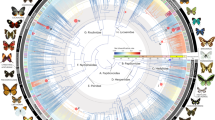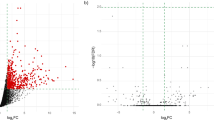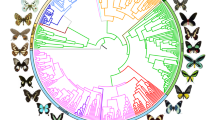Abstract
PHYTOPHAGOUS insects include many of the most species-rich genera and families worldwide1,2, and much of that diversity seems to result from speciation onto different plant species3–7. Divergence onto different host plants is thought to involve at least two sets of loci, which may be genetically linked: loci controlling the preference of ovipositing females for a particular plant species, and loci controlling the ability of larvae or nymphs to feed on those plants8–11. Others have argued that oviposition preference and larval performance may be pleiotropic effects of the same loci12–15. The genetic relationship between oviposition preference and larval performance has therefore become a central problem in the developing theory of insect and plant interactions16–23 and speciation in insects24–27. Results from interspecific crosses between two swallowtail butterfly species that feed on different plant families indicated that oviposition preference is controlled in these insects primarily by one or more loci on the X chromosome28. In a series of reciprocal interspecific crosses between these species, Papilio zelicaon and Papilo oregonius, we investigated whether larval performance on different plant species was also controlled by X-linked loci, which could allow for strong correlations between oviposition preference and larval performance. We found no X-chromosome effect for any component of larval performance. Loci from both parents influenced survivorship, and maternal effects influenced pupal mass and possibly development time. The results varied with the specific measure of performance, the host plant species used in comparing reciprocal crosses, and the sex of the larvae, all of which caution against the use of any single measure of performance in evaluating the evolutionary genetics of host shifts.
This is a preview of subscription content, access via your institution
Access options
Subscribe to this journal
Receive 51 print issues and online access
$199.00 per year
only $3.90 per issue
Buy this article
- Purchase on SpringerLink
- Instant access to full article PDF
Prices may be subject to local taxes which are calculated during checkout
Similar content being viewed by others
References
Janzen, D. H. Oxford Surveys in Evolutionary Biology 1, 85–140 (1984).
Strong, D. R., Lawton, J. H. & Southwood, R. Insects on Plants: Community Patterns and Mechanisms (Blackwell, Oxford, 1984).
Ehrlich, P. R., & Raven, P. H. Evolution 18, 586–608 (1964).
Southwood, T. R. E. in Insect/Plant Relationships (ed. van Emden, H. F.) 3–30 (Blackwell, Oxford, 1973).
Lawton, J. H. & Schroeder, D. Nature 265, 137–140 (1977).
Price, P. W. Evolutionary Biology of Parasites (Princeton University Press, 1980).
Mitter, C., Farrell B. & Wiegmann, B. Am. Nat. 231, 107–128 (1988).
Bush, G. L. in Evolutionary Strategies of Parasitic Insects and Mites (ed. Price, P. W.) 187–206 (Plenum, London, 1975).
Felsenstein, J. Evolution 35, 124–138 (1981).
Rausher, M. D. Evolution 38, 596–608 (1984).
Diehl, S. R. & Bush, G. L. in Speciation and its Consequences (eds Otte, D. & Endler, J.) 345–365 (Sinauer Associates, Sunderland, Massachusetts, 1989).
Via, S. Evolution 40, 778–785 (1986).
Jaenike, J. Heredity 59, 363–369 (1987).
Lande, R. Genetics 94, 203–215 (1980).
Futuyma, D. J. & Peterson, S. C. A. Rev. Entomol. 30, 217–238 (1985).
Bush, G. L. in Evolutionary Behavior Genetics (ed. Huettel, M. D.) 1–5 (Plenum, New York, 1987).
Butlin, R. Trends Ecol. Evol. 2, 309–311 (1987).
Futuyma, D. J. in Evolutionary Behavior Genetics (ed. Huettel, M. D.) 295–302 (Plenum, New York, 1987).
Courtney, S. P. & Chen, G. K. Fund Ecol. 2, 521–528 (1988).
Futuyma, D. J. & Moreno, G. A. Rev. Ecol. Syst. 19, 207–233 (1988).
Ng, D. Nature 334, 611–612 (1988).
Singer, M. C., Ng, D. & Thomas, C. D. Evolution 42, 977–985 (1988).
Thompson, J. N. Entomol. exp. Appl. 47, 3–14 (1988).
Tauber, C. A. & Tauber, M. J. Evol. Ecol. 1, 175–186 (1987).
Courtney Smith, D. Nature 336, 66–67 (1988).
Feder, J. L., Cholcote, C. A. & Bush, G. L. Nature 336, 61–64 (1988).
McPheron, B. A., Courtney Smith, D. & Berlocher, S. H. Nature 336, 64–66 (1988).
Thompson, J. N. Evolution 42, 1223–1234 (1988).
Miller, J. S. Bull. Am. Mus. nat. Hist. 186, 365–512 (1987).
Scriber, J. M. Tokurana (Acta Rhopal.) 6/7, 1–50 (1984).
Wiklund, C. Oikos 36, 163–170 (1981).
Berenbaum, M. Evolution 37, 163–179 (1983).
Clarke, C. A. & Larsen, T. B. Syst. Entomol. 11, 175–181 (1986).
Thompson, J. N. Evolution 42, 118–128 (1988).
Feeny, P. in Herbivory: Tropical and Temperate Perspectives (eds Price, P. W., Lewinsohn, T. M., Benson, W. W. & Fernandes, G. W.) (Wiley, New York, in the press).
Scriber, J. M., Lederhouse, R. C. & Hagen, R. H. in Herbivory: Tropical and Temperate Perspectives (eds Price, P. W., Lewinsohn, T. M., Benson, W. W. & Fernandes, G. W.) (Wiley, New York, in the press).
White, M. J. D. Animal Cytology and Evolution (Cambridge University Press, 1973).
Author information
Authors and Affiliations
Rights and permissions
About this article
Cite this article
Thompson, J., Wehling, W. & Podolsky, R. Evolutionary genetics of host use in swallowtail butterflies. Nature 344, 148–150 (1990). https://doi.org/10.1038/344148a0
Received:
Accepted:
Issue date:
DOI: https://doi.org/10.1038/344148a0
This article is cited by
-
Host selection behavior and incidence of the bark beetle Scolytus kashmirensis (Coleoptera: Curculionidae: Scolytinae) attacking elm (Ulmus spp.) trees in Kashmir
Forestry Studies in China (2012)
-
Synergistic or Antagonistic Modulation of Oviposition Response of Two Swallowtail Butterflies, Papilio maackii and P. protenor, to Phellodendron amurense by Its Constitutive Prenylated Flavonoid, Phellamurin
Journal of Chemical Ecology (2011)
-
The genetic basis of interspecies host preference differences in the model parasitoid Nasonia
Heredity (2010)
-
Escaping an evolutionary trap: preference and performance of a native insect on an exotic invasive host
Oecologia (2008)
-
Have Genetic Trade-Offs in Host Use been Overlooked in Arthropods?
Evolutionary Ecology (2005)



